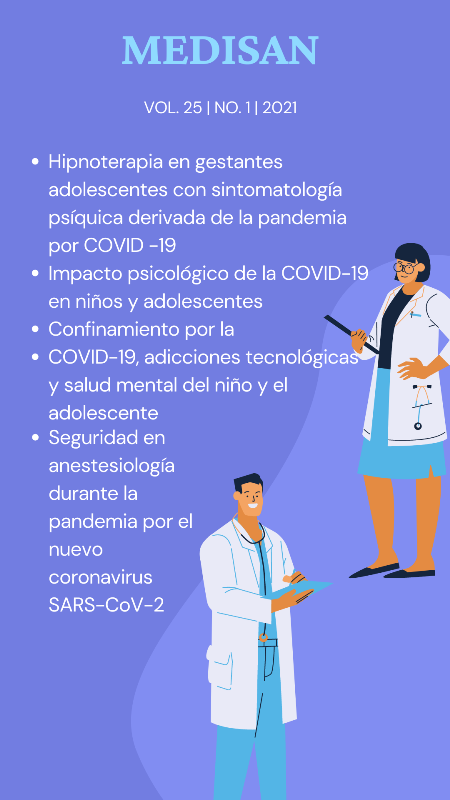Risk factors of coronary disorders in patients with ischemic heart disease included in a program of cardiovascular rehabilitation
Keywords:
ischemic heart disease, risk factors, heart rehabilitation, therapy by exercise, rehabilitation services.Abstract
Introduction: Regular physical activity can contribute to prevent diseases at the minimum cost possible, especially if it is a healthy life habit and not a risky activity that requires a strict and expensive specialized medical supervision.
Objective: To evaluate the influence of the physical exercise on risk factors of coronary disorders in patients with ischemic heart disease.
Methods: A descriptive investigation of 41 patients that had suffered from a heart attack and were part of a program of cardiovascular rehabilitation was carried out in the Physical Therapy and Rehabilitation Service of Dr. Juan Bruno Zayas Alfonso Teaching General Hospital in Santiago de Cuba, from May, 2017 to the same month in 2019. With this purpose the most frequent risk factors of coronary disorders were selected in the sample, which were analyzed before and after the implementation of the program.
Results: Risk factors prevailed in men (68.4 %), with a higher incidence of hypertriglyceridemia in both sexes (56.1 %). After the rehabilitation, a decrease of glycemia, triglycerides and serum cholesterol figures was achieved.
Conclusions: The programs of cardiovascular rehabilitation improve the health of the patients and provide as well socioeconomic benefits to the society.
Downloads
References
2. Mcphee SJ, Ganong WF. Fisiopatología médica: una introducción a la medicina clínica. 5 ed. México: El Manual Moderno; 2007. p. 257-9.
3. Hernández García S, Mustelier OJ, González Guerra R, Rivas Estany E, Rodríguez Nande L, Álvarez Gómez JA. Introducción del entrenamiento de resistencia en el programa de rehabilitación cardiovascular. Rev Cubana Cardiol Cir Cardiovasc. 2012;18(1):24-30.
4. Guyton AC, Hall JE. Tratado de Fisiología Médica. 11 ed. Madrid: Elsevier; 2010. p. 101-42.
5. Piepoli MF, Hoes AW, Agewall S, Albus C, Brotons C, Catapano AL, et al. 2016 European Guidelines on cardiovascular disease prevention in clinical practice. European Heart Journal. 2016;37(29):2315-81.
6. Pepe MS, Fan J, Feng Z, Gerds T, Hilden J. The Net Reclassification Index (NRI): a misleading measure of prediction improvement even with independent test data sets. Stat Biosci. 2015 [citado 23/01/2020];7:282-95. Disponible en: https://www.ncbi.nlm.nih.gov/pmc/articles/PMC4615606/
7. Inouye M, Abraham G, Nelson CP, Wood AM, Sweeting MJ, Dudbridge F, et al. Genomic risk prediction of coronary artery disease in nearly 500,000 adults: implications for early screening and primary prevention. bioRxiv. 2018 Ene [citado 23/01/2020]. Disponible en: https://core.ac.uk/download/pdf/162916267.pdf
8. Khera AV, Emdin CA, Drake I, Natarajan P, Bick AG, Cook NR, et al. Genetic Risk, Adherence to a Healthy Lifestyle, and Coronary Disease. N Engl J Med. 2016;375(24):2349-58.
9. Assimes TL, Roberts R. Genetics: Implications for Prevention and Management of Coronary Artery Disease. J Am Coll Cardiol. 2016;68(25):2797-818.
10. Carey RM, Whelton PK, Aronow WS, Casey DE, Collins KJ, Dennison Himmelfarb C, et al. Prevention, Detection, Evaluation, and Management of High Blood Pressure in Adults: Synopsis of the 2017 American College of Cardiology/American Heart Association Hypertension Guideline. Ann Intern Med. 2018 [citado 23/01/2020]. Disponible en: https://doi.org/10.7326/M17-3203
11. Boraita Pérez A, Baño Rodrigo A, Berrazuela Fernández JR, Lamiel Alcaine R, Luengo Fernández E, Manonelles Marqueta P, et al. Guías de práctica clínica de la Sociedad Española de Cardiología sobre la actividad física en el cardiópata. Rev Esp Cardiol. 2000;53(5):684-726.
12. Abdi A, Basgut B. An Evidence-Based Review of Pain Management in Acute Myocardial Infarction. J Cardiol Clin Res. 2016;4(4):1067.
13. Anderson TJ, Gregoire J, Pearson GJ, Barry AR, Couture P, Dawes M, et al. 2016 Canadian Cardiovascular Society guidelines for the management of dyslipidemia for the prevention of cardiovascular disease in the adult. Can J Cardiol. 2016;32(11):1263-82.
14. Chukwudozie A, White H. Las intervenciones de ejercicios físicos ayudan a mejorar la autoestima en niños y jóvenes en el corto plazo, pero se requieren más investigaciones. Caracas: The Campbell Collaboration; 2018.
15. Leung AA, Daskalopoulou SS, Dasgupta K, McBrien K, Butalia S, Zarnke KB, et al. Hypertension Canada's 2017 Guidelines for Diagnosis, Risk Assessment, Prevention, and Treatment of Hypertension in Adults. Can J Cardiol. 2017;33(5):557-76.
16. Knowles JW, Ashley EA. Cardiovascular disease: The rise of the genetic risk score. PLOS Med. 2018 [citado 23/01/2020];15(3). Disponible en: https://doi.org/10.1371/journal.pmed.1002546
17. Xu X, Mishra GD, Dobson AJ, Jones M. Progression of diabetes, heart disease, and stroke multimorbidity in middle-aged women: A 20-year cohort study. PLOS Med. 2018 [citado 23/01/2020];15(3). Disponible en: https://doi.org/10.1371/journal.pmed.1002516
Published
How to Cite
Issue
Section
License
All the articles can be downloaded or read for free. The journal does not charge any amount of money to the authors for the reception, edition or the publication of the articles, making the whole process completely free. Medisan has no embargo period and it is published under the license of Creative Commons, International Non Commercial Recognition 4.0, which authorizes the copy, reproduction and the total or partial distribution of the articles in any format or platform, with the conditions of citing the source of information and not to be used for profitable purposes.






